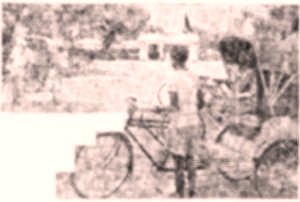

Home | Biodata | Biography | Photo Gallery | Publications | Tributes
Political - Socio - Economic-Surveys

 |

Home | Biodata | Biography | Photo Gallery | Publications | Tributes Political - Socio - Economic-Surveys |
 |
Has the DMK become stronger in Tamilnadu than it was four years ago? What percentage of voters in Tamilnadu is in favor of the Old Congress? How effective is the support for the Swatantra Party? Is it the Old Congress or the DMK that enjoys greater support from the voters?
To answer these and other Interesting questions, a pre-election study was conducted by the Department of
Statistics, Madras Christian College, during the first week of February with financial support from the University Grants Commission. The investigators were volunteers from the
They interviewed more than 1,500 voters who were chosen by random sampling techniques. Even though pre-election studies are quite common in the West, this is the first time a study of this nature has been attempted in Tamilnadu.
Not Heard of
Given only the proportion of votes a party is likely to get in Tamilnadu, it is not possible to predict with any reasonable accuracy the number of seats a party will win. Assuming that there are only straight contests a party with 40 per cent support may win even up to 80 per cent of the seats. This is possible if the party contests only in 8 of 10 seats and secures a bare majority in each case. On the other hand, the party may contest all the seats and lose every one of them by securing about 40 per cent of the votes in every case. In other words a party may win a number of seats if it has a bare majority in most of the constituencies rather than its support being weakly spread over the entire State.
The purpose of this study is not to predict the number of seats that will be won by the different parties but to estimate the proportion of votes each party is likely to get if the elections are conducted now. If one were to attempt to predict the number of seats, a detailed study of each constituency has to be made with a much larger sample.
Strange as it may seem, about one-fifth of the voters interviewed have not heard the name of the Swatantra Party, and more than about 40 per cent the Jan Sangh. The majority of the voters of Tamilnadu have not come across the names of the SSP, the PSP and the Tamilnadu Toilers' Party. More than 35 per cent of the voters have not heard of either the CPI or the CPM. Apparently, these parties are probably in certain pockets where they field their candidates with the support of the DMK and the Old Congress. On the other hand, only about 1 per cent of the voters interviewed have not heard of the DMK and 2 per cent the Old Congress. It looks as though the smaller parties gain more from these electoral alliances than the main contestants.
One may wonder whether the voter is willing to discuss with our young investigators their voting preferences. However, we were surprised by the openness and friendliness of the ordinary voters--only about 10 per cent of the voters refused to reveal their voting intentions.
Still Stronger
Each voter was asked about a dozen political parties of Tamilnadu and was also told about the actual parties contesting in his constituency. For each party, the voter was asked whether he would definitely vote for, definitely not vote for, or may or may not. For the Assembly, the DMK gets 43 per cent definite votes and 5 per cent may or may not, whereas the Old Congress gets 37 per cent of definite votes with 5 per cent may or may not. Since there are no official New Congress candidates, there are no votes for the party for the Assembly.
The Muslim League gets 1 per cent, CPI 2 per cent and the Forward Bloc 1 per cent. Swatantra gets 2 per cent, Tamilnad Toilers 1 per cent, and the Jan Sangh almost none. This shows that for the Assembly, the DMK remains the stronger contestant.
The district-wise distribution of the support of the parties for the Assembly also shows that the DMK has a clear edge over the Old Congress at the moment.
For Parliament, the DMK is supported by 38 per cent definite votes and the Old Congress 36 per cent. In addition, 5 percent are undecided about voting for the DMK and the Old Congress. The contest is quite close. The New Congress gets a support of 6 per cent. Muslim League 1 per cent, CPI 3 per cent and the Forward Bloc 1 per cent. This is matched by Swatantra 3 per cent. The DMK led alliance scores over its opponents with 48 per cent as against 39 per cent.
The sampling errors in this kind of work are likely to be higher than the theoretical figures, since in many cases the list of voters was not up-to-date.
Change of Loyalty
Will those who voted for the DMK in the last elections continue to support it in the coming elections? Three fourths of the voters say they will. About 15 per cent of the former DMK supporters will vote for the Old Congress. From among those who voted for the undivided Congress in the last elections, 78 per cent will support the Old Congress and 10 per cent will switch over to the DMK.
Do all the members of a joint family vote for the same party? No, only 60 per cent of them do. This, perhaps, is not surprising. However, in small families, in less that 50 per cent of the cases, the husband and the wife make joint decisions and 40 per cent of them say they take independent decisions with regard to voting. This means that those who canvass for the parties ought to ask for the support of both the husband and the wife individually and not take for granted the influence of the husband over the wife.
From the figures for the Assembly, it is clear that the DMK continues to enjoy the confidence of a large section of the people. The Old Congress has captured almost all the votes of the undivided Congress. Many people in the rural areas are not aware of the historic split in the Congress and the word Congress, is invariably associated with Mr Kamaraj.
TABLE I
Assembly: Distribution of Votes (%)
| Party | Not heard of | Definitely vote for | Definitely not vote for | May or may not | Will not reveal | |
| DMK | 1.2 | 43.1 | 44.3 | 4.8 | 6.6 | 100 |
| Old Congress | 2.4 | 36.9 | 49.2 | 4.7 | 6.8 | 100 |
| Muslim League | 27.5 | 1.3 | 55.5 | 2.9 | 12.8 | 100 |
| CPI | 36.0 | 1.9 | 48.3 | 2.0 | 11.8 | 100 |
| CPM | 36..5 | 1.4 | 52.0 | 1.0 | 9.1 | 100 |
| SSP | 50.4 | - | 38.7 | 0.9 | 10.0 | 100 |
| PSP | 50.3 | 0.6 | 38.5 | 0.6 | 10.0 | 100 |
| Swatantra | 19.9 | 2.2 | 59.0 | 3.1 | 15.7 | 100 |
| Jan Sangh | 43.0 | 0.3 | 45.0 | 1.1 | 10.6 | 100 |
| Forward Bloc | 48.3 | 1.3 | 40.1 | 1.5 | 8.7 | 100 |
| Tamilnad Toilers | 51.8 | 1.0 | 37.8 | 1.5 | 8.4 | 100 |
From the above parties alone
DMK-led alliance 48.2
Old Congress Front 40.1
TABLE II
Assembly: District-wise Distribution of Parties
| District | Dominant Party |
| Madras | DMK |
| Chingleput | Old Congress |
| N Arcot | DMK |
| S Arcot | DMK |
| Salem | DMK |
| Coimbatore | DMK |
| Nilgiris | Old Congress |
| Madurai | Old Congress |
| Trichy | DMK |
| Tanjore | Old Congress |
| Ramnad | DMK |
| Tirunelveli | Both |
| Kanyakumari | DMK |